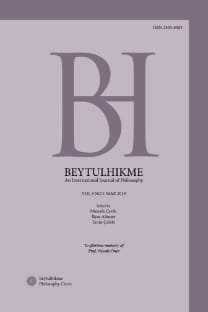Tarski's Semantic Definition of Truth
Tarski's Semantic Definition of Truth
Alfred Tarski (1902-1983) provides a ground-breaking account of truth in his famous “The Concept of Truth in Formalized Languages” (originally 1933). To have an adequate grasp of this account, which has had a huge impact on subsequent discussions and investigations concerning truth, is necessary for a proper understanding of contemporary discussions about truth. Our aim in this paper is to give a clear presentation of Tarski’s account of truth.
___
- Davidson, D. (2001). Semantics for natural languages. İçinde: Inquiries into truth and interpretation (ss. 55-64). Oxford: Clarendon Press.
- Field, H. (1972). Tarski’s theory of truth. The journal of philosophy, 69(13), 347-375. https://doi.org/10.2307/2024879
- Gruber, M. (2016). Alfred Tarski and the “concept of truth in formalized languages”: A running commentary with consideration of the Polish original and the German translation. Springer International Publishing.
- Grünberg, T. (2000). Sembolik mantık el kitabı: 1. Cilt: Temel mantık. Ankara: METU Press.
- King, J. C. (2006). Semantics. İçinde: D. M. Borchert (Ed.), Encyclopedia of philosophy (2nd ed., Vol. 8, pp. 735–750). Thomson Gale/Macmillan Reference USA. Koreň, L. (t.y). Semantic conception of truth: what it is and what it is not.
- https://www.academia.edu/1410755/Semantic_Conception_ of_Truth._What_It_Is_and_What_It_Is_Not adresinden 8 Eylül 2021’de erişilmiştir. (Bu çalışma, Koreň’in (2011) gözden geçirilmiş bir biçimidir.)
- Koreň, L. (2011). Truth and meaning: the dialectics of theory and practice. [Doktora tezi, Charles University in Prague]. Charles University Digital Repository. http://hdl.handle.net/20.500.11956/47037
- Künne, W. (2003). Conceptions of truth. Oxford: Clarendon Press.
- McGinn, C. (2015). Philosophy of language: Classics explained. Cambridge, Massachusetts/ London, England: The MIT Press.
- Moreno, L. F. (2001). Tarskian truth and the correspondence theory. Synthese, 126(1-2), 123-147.
- Özlem, D. (2012). Mantık (2. Baskı). İstanbul: Notos.
- Patterson, D. (2012). Alfred Tarski: Philosophy of language and logic. Palgrave Macmillan.
- Rojszczak, A. (1999). Why should a physical object take on the role of truth-bearer? İçinde: Woleński, J. ve Köhler, E. (Eds.), Alfred Tarski and the Vienna Circle. Springer. (ss. 115-125).
- Soames, S. (1999). Understanding truth. New York ve Oxford: Oxford University Press.
- Tarski, A. (1933). Pojęcie prawdy w językach nauk dedukcyjnych. Prace towarzystwa naukowego warszawskiego. Wydział III: Nauk Matematyczno-Fizycznych. 34. PWN Warszawa.
- Tarski, A. (1935). Der Wahrheitsbegriff in den formalisierten Sprachen. İçinde: Studia philosophica commentarii societatis philosophicae polonorum (Cilt I). Leopoli Lemberg.
- Tarski, A. (1944). The semantic conception of truth: and the foundations of semantics. Philosophy and phenomenological research, 4(3), 341.
- Tarski, A. (1956). The concept of truth in formalized languages. İçinde: J. H.
- Woodger (Ed. ve Çev.), Logic, semantics, metamathematics: Papers from 1923 to 1938 by Alfred Tarski (ss. 152-278). Oxford Clarendon Press.
- Tarski, A. (1969). Truth and proof. Scientific American, 220(6), 63-77.
- ISSN: 1303-8303
- Başlangıç: 2011
- Yayıncı: Mustafa Çevik
Sayıdaki Diğer Makaleler
Çağdaş Analitik Epistemolojiye (veya Gettierolojiye) Metodolojik Bir Eleştiri: Poppercı Yaklaşım
Why Study Medieval Philosophy?
Is Ignorance a Part of Virtue?
Ambiguity, Dissensus and Subjectification: Antigone
Seeing Phenomenon in Wittgenstein
Genel Bilim Felsefesi Üzerine Yazılmış Türkçe Kitapların Tema Analizi
Two Eyes of Human as Thinking Being: Education and Morality
Evaluation of Spinoza's Concept of Freedom in the Light of Neuroscientific Experiments
Martin Buber’in Ben-Sen Felsefesi, Eğitim Anlayışı ve Eğitime Dair Metaforları
